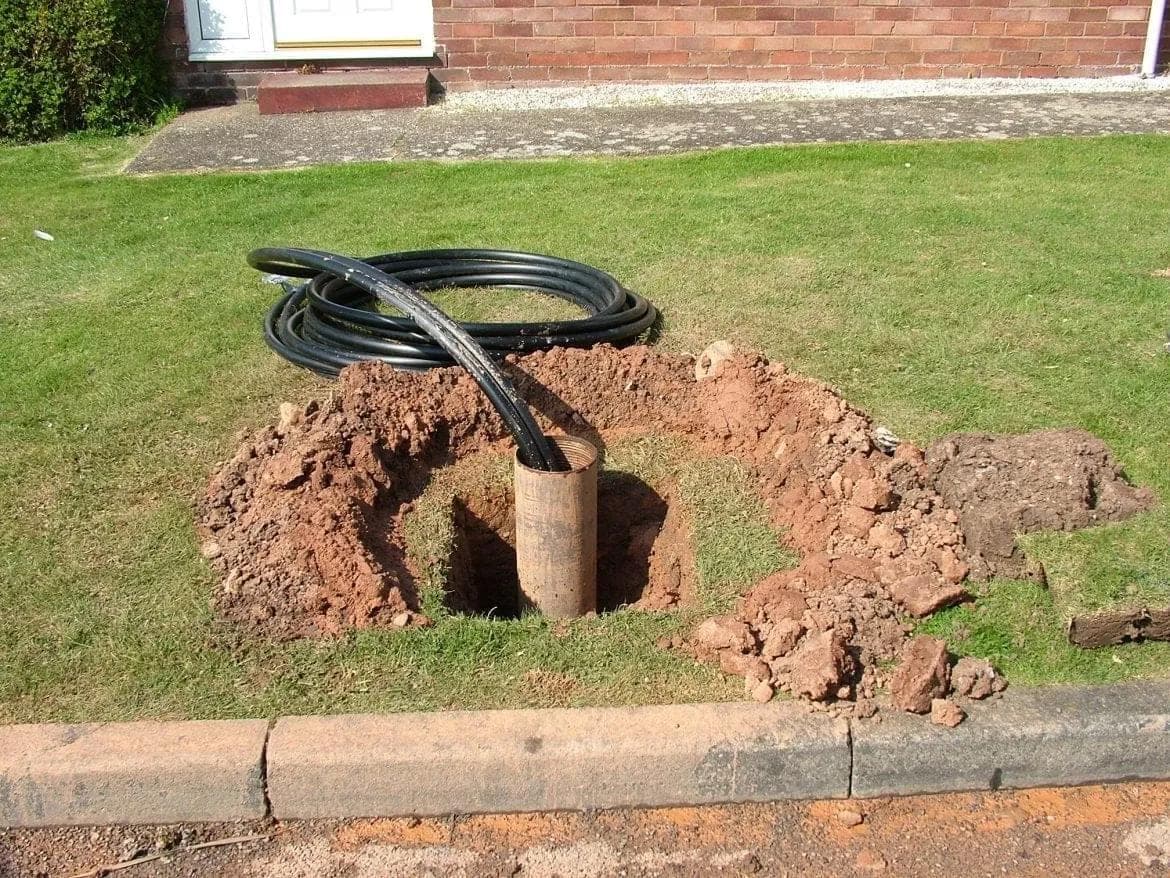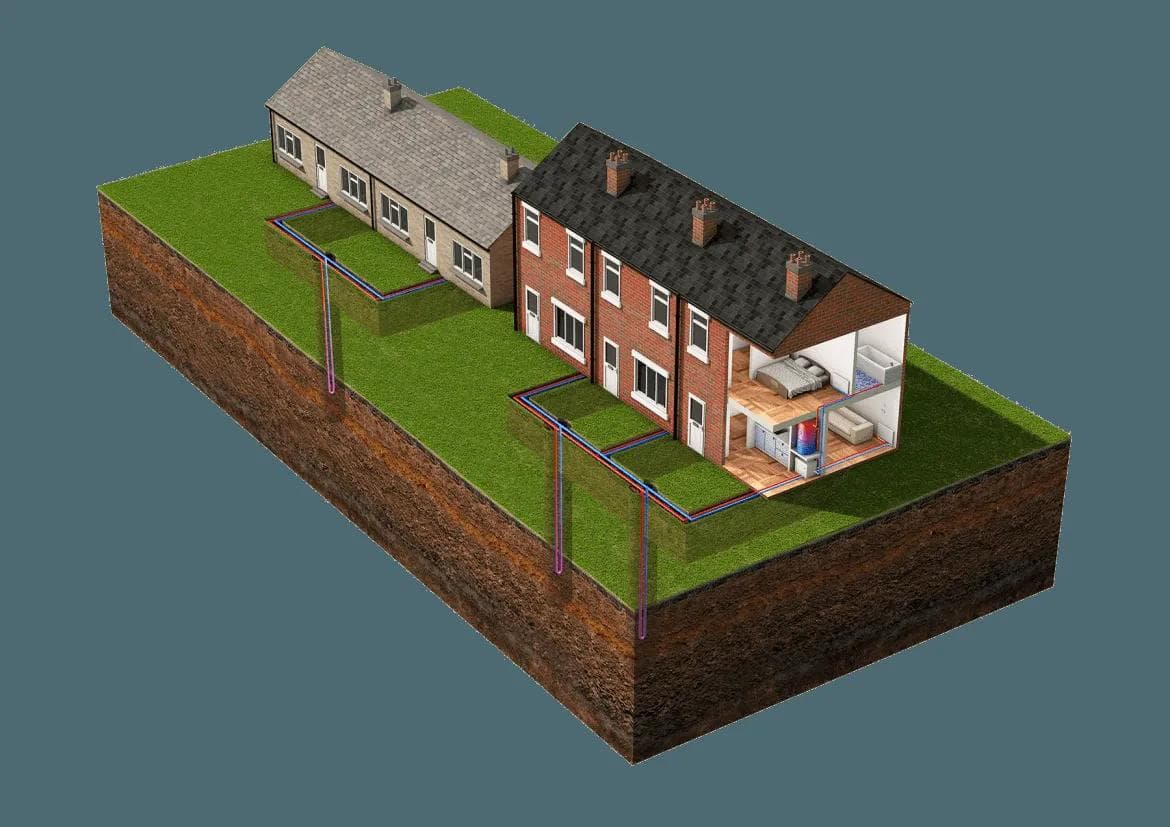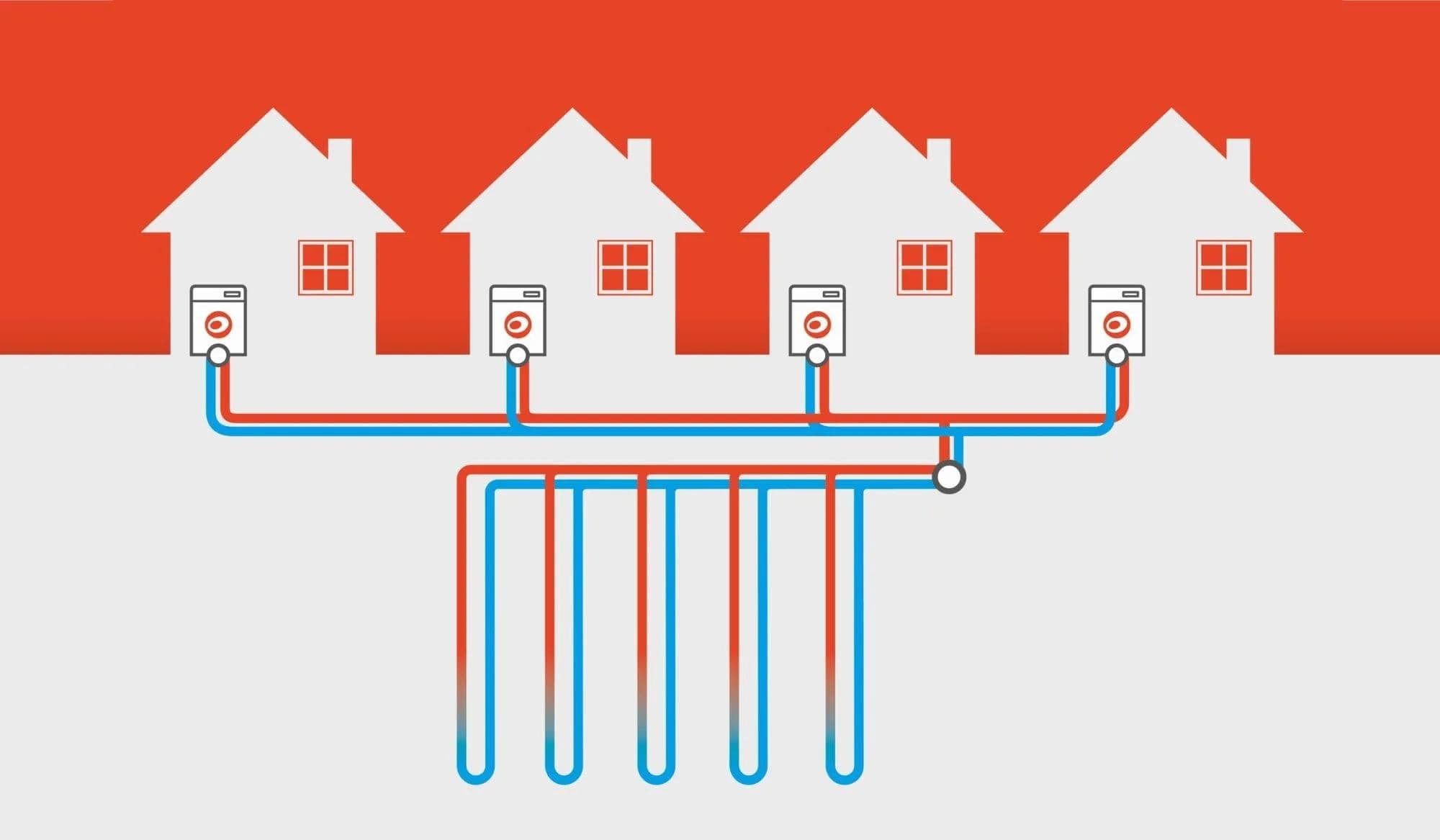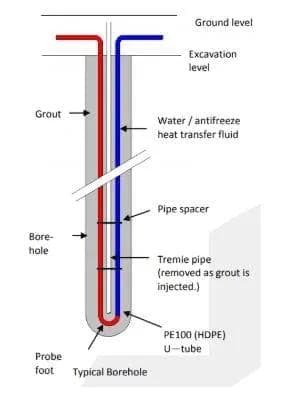Are there different types of boreholes?
There are two types of boreholes that can be used with ground source heat pumps: closed loop and open systems.

Ground source heat pump boreholes are vertical ground arrays or collectors used to extract heat energy from rock to a ground source heat pump. They save space and minimise disruption in heat pump installation projects, as you usually only need 150mm width of garden space per borehole. Depths of boreholes range from around 60m to 200m.
A borehole is a more expensive alternative to slinky pipes, as there is an additional cost to preparing and drilling the borehole.
However, boreholes become economically viable on Networked Heat Pump schemes for multiple residential properties, large commercial projects and any site with heat loads above 100kW. This is due to reduced mobilisation costs for the drilling rig, efficiencies of scale when on site, and the degree of diversification being applied.
In larger projects featuring shared ground loops, borehole depths or numbers are reduced compared to individual system installations.
There are two types of boreholes that can be used with ground source heat pumps: closed loop and open systems.



Ground source heat pump boreholes are generally used for Networked Heat Pump schemes, large commercial projects with high heat demands, or smaller sites where space saving is a priority. They’re also ideal when there is insufficient space for horizontal arrays such as slinky pipes in trenches.
Boreholes are Kensa’s preferred ground array for clusters of properties connected to Networked Heat Pumps, which is common in social housing or new-build development schemes.
Typically one borehole is required per property. However, in Networked Heat Pump schemes, one deeper borehole could serve two properties, hence why they are referred to as a Shared Ground Loop Array.


The design of boreholes for small, individual applications can be calculated with tables, empirical values and guidelines. A popular parameter to calculate the required depth of a borehole is through the ground’s specific heat extraction properties, which is expressed as Watt per metre borehole length (W/m).
A borehole’s performance is dependent on the location’s geology and its thermal conductivity, the efficiency of the heating distribution system and the building’s heat demand. Typically, a 75 to 100m borehole provides 3 to 5 kW of extractable heat based on 1800 running hours a year.\n\nFor larger commercial projects, such as those with heat demands above 100kW, a thermal response test (TRT) is required to calculate accurate borehole sizing.
A geological survey will provide an indication of the type of material that the borehole is going to be drilled into. This material can determine the design of the borehole field.
Different geological conditions have different heat transfer characteristics. For example, a borehole in loose stones has an energy extraction rate of approximately 20 watt per metre (W/m), while granite has an extraction rate of 55 to 70W/m.
A geological survey should also indicate whether there are any mine workings or aquifers present. In these instances, an open loop borehole may utilise the high thermal conductivity properties in the subterranean water sources.
For projects using multiple boreholes in a Shared Ground Loop Array, such as Networked Heat Pump schemes or large heat demand commercial projects, the boreholes should be spaced at 5 to 6m between centres to avoid any interference between each ground collector. This ensures the ground can recover its heat, and stops the ground from freezing.

The design of boreholes for small, individual applications can be calculated with tables, empirical values and guidelines. A popular parameter to calculate the required depth of a borehole is through the ground’s specific heat extraction properties, which is expressed as Watt per metre borehole length (W/m).
A borehole’s performance is dependent on the location’s geology and its thermal conductivity, the efficiency of the heating distribution system and the building’s heat demand. Typically, a 75 to 100m borehole provides 3 to 5 kW of extractable heat based on 1800 running hours a year.\n\nFor larger commercial projects, such as those with heat demands above 100kW, a thermal response test (TRT) is required to calculate accurate borehole sizing.
A geological survey will provide an indication of the type of material that the borehole is going to be drilled into. This material can determine the design of the borehole field.
Different geological conditions have different heat transfer characteristics. For example, a borehole in loose stones has an energy extraction rate of approximately 20 watt per metre (W/m), while granite has an extraction rate of 55 to 70W/m.
A geological survey should also indicate whether there are any mine workings or aquifers present. In these instances, an open loop borehole may utilise the high thermal conductivity properties in the subterranean water sources.
For projects using multiple boreholes in a Shared Ground Loop Array, such as Networked Heat Pump schemes or large heat demand commercial projects, the boreholes should be spaced at 5 to 6m between centres to avoid any interference between each ground collector. This ensures the ground can recover its heat, and stops the ground from freezing.
A borehole consists of a hole drilled between 60 to 200m deep. Typically, the diameter of a borehole is around 110 to 150mm, but this depends on the type of machine being used to drill the borehole. It also depends on the diameter of the borehole pipe, which is usually between 32 to 40mm.
The first few metres of a borehole is generally sleeved with a casing to prevent the sides from collapsing. The depth of this casing depends on the material that the borehole is drilled into and the depth of soil.
Multiple boreholes are generally placed 5 to 6m apart. However, for large commercial projects, the interference from one borehole to another must be calculated to ensure there is adequate spacing and sufficient depth between them.
The drilling rigs used for boreholes come in many shapes and sizes. Small drilling rigs can operate in restricted access sites and small gardens, while others are designed for larger commercial projects.
A single loop of pipe – usually PE100 HDPE or Pex pipe – is inserted into the borehole. Along with the borehole pipe, a small tremie pipe, which is about 25 to 40mm, is also attached to the borehole pipe.
The tremie pipe is used to fill the borehole with thermal grout and is withdrawn as the grout is injected. The grout provides a thermal path, which allows the energy within the ground to be absorbed by the fluid circulating the borehole pipe. The driller will take responsibility for grouting the hole using specialist pumping equipment.
Single loops are normally used in the UK, but it’s possible to use a twin loop or duplex system to try and extract more energy.
A larger diameter hole is required for a twin loop system, and the borehole’s energy yield only increases by an approximate factor of 1.25. This also depends on the hole and pipe diameter, the distance from the next borehole, how the pipe is inserted, and the thermal grouting. The pipe is either filled with water or weighted at the end, making it easier to insert into the borehole.
The drilling contractor will perform a pressure test, cap the plastic ground array pipe, and issue a certificate before leaving the site.
For larger commercial projects (nominally over 100kW), guidelines tend to overestimate the number of required boreholes. It’s recommended that a thermal response test (TRT) is carried out on a representative borehole. A thermal geologist can then combine the results from a TRT, with the heating and cooling profile of the building, to calculate the type, depth, number and spacing of boreholes. The cost of completing a TRT is generally recovered in the reduction in the number of boreholes required.
If more than one borehole is required, the pipes should be connected using a manifold. This ensures equal distribution of flow across each borehole. Manifolds can be located at the building or the pipes can be connected in a subterranean manifold within a trench at the edge of the bore field.
To avoid any joints and eliminate the need for any electrofusion welding – which requires specialist equipment and can attract additional costs – it’s sensible to use specially extended borehole probes. These are simply laid in a trench between the top of the borehole and the manifold on the side of the building.
Kensa recommends you compare the rates of groundwork contractors and drilling contractors to identify the best price for this trenching work.